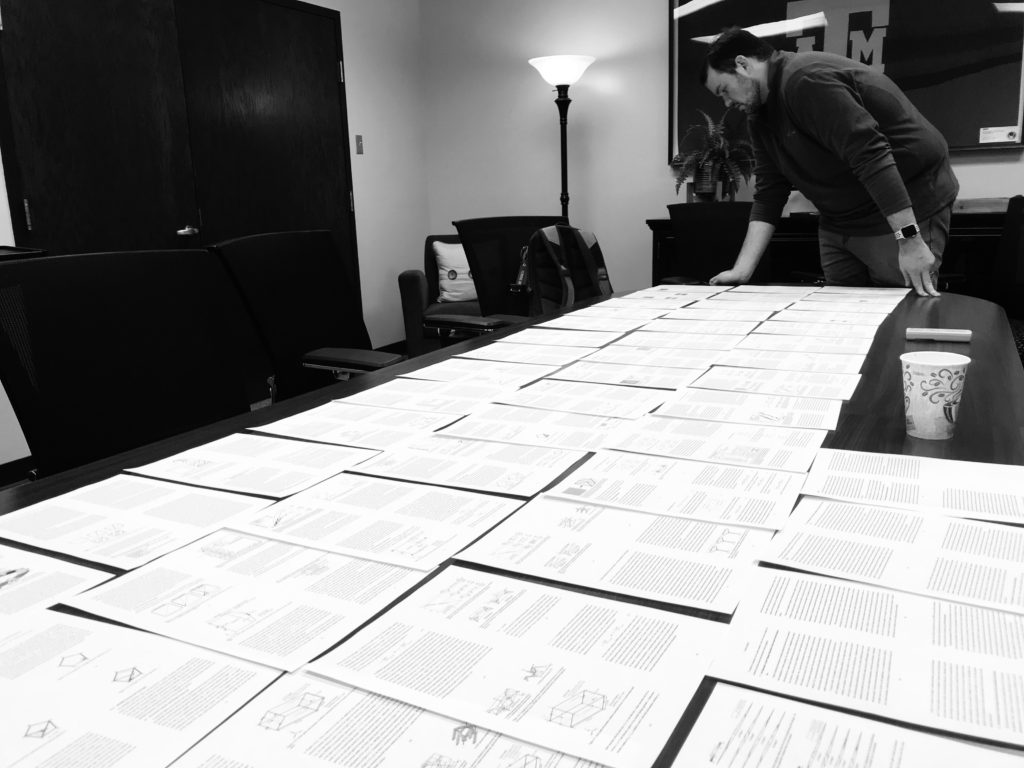
Brent Bielefeldt completes a final review of his dissertation document with Dr. Hartl just prior to his defense.
On March 2, 2020, Brent Bielefeldt became Dr. Hartl’s second advisee to complete all necessary requirements for his doctoral degree in Aerospace Engineering. The contributions of his dissertation, entitled “Multiobjective Topology Optimization for Preliminary Design Using Graph Theory and L-System Languages,” have already been adopted by the Air Force Research Laboratory, where he is now working as a prestigious National Research Council Postdoctoral Fellow.
Brent joined the MAESTRO Laboratory after completing a B.S. in Mechanical Engineering at the University of Alabama, where he was granted a full scholarship out of high school. After interning at the Air Force Research Laboratory, he became enamored with the possibility of using genetic programming to represent and then design structural layouts, especially in three dimensions. He developed an entirely new data structure for representing structural topologies that has been adopted by a number of groups for continued research, and he is expected to begin authorship of a published book on the topic with Hartl and collaborator (and inspiration) Marcelo Kobayashi.
The full text of Dr. Bielefeldt’s dissertation abstract is as follows: “Topology optimization is a powerful preliminary design tool that can determine potential structural configurations to best satisfy specified performance objectives, but its use requires significant user knowledge or intuition regarding the specific problem considered. Advancements in the area of smart materials and a growing interest in designing structures with increased multifunctionality have highlighted a growing need for an inherently multiobjective approach capable of identifying well- performing solutions to problems with which users have little/no intuition or experience. This work proposes the use of a heuristic alternative to conventional topology optimization approaches which couples a genetic algorithm with a parallel rewriting system known as a Lindenmayer System (L- System). The L-System encodes design variables into an array (e.g., character string) which, when interpreted by a deterministic algorithm, governs the development of the topology. In particular, this work explores a newly developed graph-based approach referred to as Spatial Interpretation for the Development of Reconfigurable Structures (SPIDRS). This algorithm is based on the nodes, edges, and faces of a planar graph, allowing for an edge- and face constructing agent to move more freely around the design space and introduce deliberate and natural topological modifications. This graph-based approach can also be extended to consider three-dimensional structural design domains, representing the first known demonstration of 3-D L-System topology optimization. It will be demonstrated that the proposed L-System topology optimization framework effectively explores the physical design space and results in configurations comparable to both known optimal or ideal solutions as well as those found using conventional topology optimization methods, but with the advantage of straightforward multiobjective/multiphysical extension. The implementation of a sizing optimization scheme to determine optimal structural member thicknesses for SPIDRS-generating topologies will also be discussed, and several potential multiphysical design applications will be introduced.”
